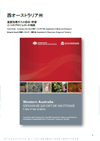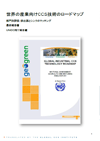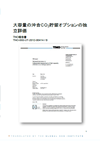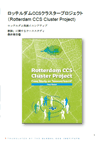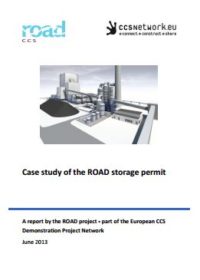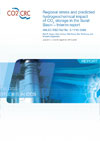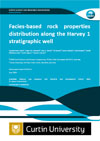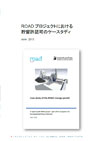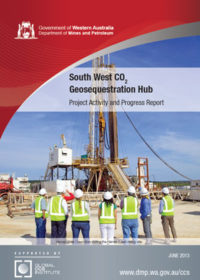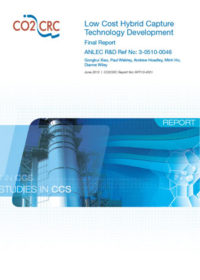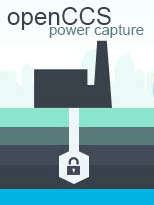Resources
Publications
Our publications, reports and research library hosts over 500 specialist reports and research papers on all topics associated with CCS.
View our Publication Library Disclaimer.
Filter by
西オーストラリア州 温室効果ガスの回収・貯留: 二つのプロジェクトの物語
6th June 2013
Topic(s): Carbon capture use and storage (CCUS), Health safety and environment
本書ではこれらの最先端のプロジェクトの相違点及び共通点を検証する。
Disclaimer
The content within the Global CCS Institute Publications, Reports and Research Library is provided for information purposes only. We make every effort and take reasonable care to keep the content of this section up-to-date and error-free. However, we make no claim as to its accuracy, currency or reliability.
Content and material featured within this section of our website includes reports and research published by third parties. The content and material may include opinions and recommendations of third parties that do not reflect those held by the Global CCS Institute.
世界の産業向けCCS技術のロードマップ 部門別評価:排出源とシンクのマッチング
6th June 2013
Topic(s): Carbon capture use and storage (CCUS)
Disclaimer
The content within the Global CCS Institute Publications, Reports and Research Library is provided for information purposes only. We make every effort and take reasonable care to keep the content of this section up-to-date and error-free. However, we make no claim as to its accuracy, currency or reliability.
Content and material featured within this section of our website includes reports and research published by third parties. The content and material may include opinions and recommendations of third parties that do not reflect those held by the Global CCS Institute.
ISAのフェーズ3は、商業ベースのCCS大規模普及の後押しとなるべく、大容量沖合貯留の利用可能性に更なる確実性をもたらすとともに、潜在的なCCSプロジェクト開発者に、プロジェクトを遂行した場合の長期的実行可能性についてより大きな信頼感を提供することを目的としている。これらの目的は、オランダ政府による陸上CO2貯留に遅延が生じているため、さらに重要性を増している。
Disclaimer
The content within the Global CCS Institute Publications, Reports and Research Library is provided for information purposes only. We make every effort and take reasonable care to keep the content of this section up-to-date and error-free. However, we make no claim as to its accuracy, currency or reliability.
Content and material featured within this section of our website includes reports and research published by third parties. The content and material may include opinions and recommendations of third parties that do not reflect those held by the Global CCS Institute.
ロッテルダムCCSクラスタープロジェクト – 教訓」に関するケーススタディ
5th June 2013
Topic(s): Carbon capture use and storage (CCUS), CO2 hubs
ロッテルダム気候イニシアティブ(RCI: Rotterdam Climate Initiative)は、ロッテルダム地域においてCO2回収貯留(CCS)を実現するため、懸命に取組を続けている。ロッテルダムにおけるCCS活動は2006年に始まり、現在までに18を超える大手企業が協力し、CO2回収プロジェクト及びCCSインフラネットワークに関する、実行可能性レベルでの工学調査を実施してきた。
本書はこのケーススタディの最終報告書である。以下の四つのテーマを取り扱っている。
- 理解可能なストーリー展開-第2章では、ロッテルダムCCS手法に関する出来事の全てを簡潔に要約した。
- (新規及びオリジナルの)拡張分析-第3章では、4者の外部利害関係者による多面的な解析により、読者はロッテルダム手法の長所及び短所をより鮮明に把握できるはずである。我々が選んだ利害関係者の意見は、政治家、政策立案者、起業家、(CCS)ネットワーク事務局のものである。それぞれの意見から、読者はロッテルダムで何が起きたかについての見解及び印象を得ることができる。
- 新たなCCSプロジェクトの創始者のためのマニュアル-第4章では、ロッテルダムで学んだ教訓から、プロジェクトを開始するリーダーのためのガイドラインを作成した。ガイドラインは、信頼関係の構築、クラスタープロジェクトの組織化、貯留の利用可能化、コミュニケーション及び支援運動の問題などを扱っている。
- ケーススタディの「インとアウト」に関する考察-第5章では、1年以上に及んだ興味深い作業(労働時間は3,000時間弱)を検討する。この検討では、本ケーススタディの結果やワークショップ及び知識共有への適用において、用いた理論とその応用を扱っている。本章は今後の作業のための提案で締めくくっている。
Disclaimer
The content within the Global CCS Institute Publications, Reports and Research Library is provided for information purposes only. We make every effort and take reasonable care to keep the content of this section up-to-date and error-free. However, we make no claim as to its accuracy, currency or reliability.
Content and material featured within this section of our website includes reports and research published by third parties. The content and material may include opinions and recommendations of third parties that do not reflect those held by the Global CCS Institute.
Case study of the ROAD storage permit
1st June 2013
Topic(s): Carbon capture use and storage (CCUS), CO2 storage, Permitting
Disclaimer
The content within the Global CCS Institute Publications, Reports and Research Library is provided for information purposes only. We make every effort and take reasonable care to keep the content of this section up-to-date and error-free. However, we make no claim as to its accuracy, currency or reliability.
Content and material featured within this section of our website includes reports and research published by third parties. The content and material may include opinions and recommendations of third parties that do not reflect those held by the Global CCS Institute.
Building capacity for CO2 capture and storage in the APEC region: A training manual for policy makers and practitioners
1st June 2013
Topic(s): Capacity development, Carbon capture use and storage (CCUS)
This APEC training package is designed to assist APEC member economies to understand the potential of CO2 Capture and Storage (CCS), as well as the science and process involved in identifying and implementing a CCS project.
Disclaimer
The content within the Global CCS Institute Publications, Reports and Research Library is provided for information purposes only. We make every effort and take reasonable care to keep the content of this section up-to-date and error-free. However, we make no claim as to its accuracy, currency or reliability.
Content and material featured within this section of our website includes reports and research published by third parties. The content and material may include opinions and recommendations of third parties that do not reflect those held by the Global CCS Institute.
Regional stress and predicted hydrogeochemical impact of CO2 storage in the Surat Basin: interim report
1st June 2013
Topic(s): Carbon capture use and storage (CCUS), CO2 storage
Early results of hydro-geochemical modelling for CO2 storage in the Surat Basin. This research is highly relevant to both potential CO2 injection operators and those statutory bodies that must regulate geosequestration operations in low salinity aquifers. The report provides early model assessments of geochemical influences of a greenhouse gas stream on both reservoir and seal rock types and the associated water chemistry. Importantly, these models use injection fluid compositions of CO2 , SOx and NOx that are broadly indicative of the composition of the major components of a GHG Stream sourced from coal-fired power stations.
Disclaimer
The content within the Global CCS Institute Publications, Reports and Research Library is provided for information purposes only. We make every effort and take reasonable care to keep the content of this section up-to-date and error-free. However, we make no claim as to its accuracy, currency or reliability.
Content and material featured within this section of our website includes reports and research published by third parties. The content and material may include opinions and recommendations of third parties that do not reflect those held by the Global CCS Institute.
Facies-based rock properties distribution along the Harvey 1 stratigraphic well
1st June 2013
Topic(s): Carbon capture use and storage (CCUS)
The goal of the multidisciplinary work presented here is to help enable and further understand the geological and geophysical parameters that will affect the safe and efficient storage of CO2 at the proposed SW-Hub site in the Southern Perth Basin. In particular, the areas of interests covered by this work are related to the characterization of the geological units intersected by Harvey-1 in terms of storage capacity; injectivity and containment potential; elastic and mechanical properties and heterogeneity of the formations encountered.
Disclaimer
The content within the Global CCS Institute Publications, Reports and Research Library is provided for information purposes only. We make every effort and take reasonable care to keep the content of this section up-to-date and error-free. However, we make no claim as to its accuracy, currency or reliability.
Content and material featured within this section of our website includes reports and research published by third parties. The content and material may include opinions and recommendations of third parties that do not reflect those held by the Global CCS Institute.
CCSプロジェクトの許可を得るのは、特に貯留許可が義務付けられているため、長く困難なプロセスである。貯留許可に関する規制(CCS指令、ガイダンス文書)は新しいものなので、いくつかの重要な細かい点を様々に解釈することができる。ROADプロジェクトの場合、貯留許可のプロセスに合計で2年近くを費やした。ROADは幸運にも、オランダの所轄当局から実証プロジェクトへの全面的な支援を得ることができた。他のプロジェクトではこの様には行かないかもしれないが、CCS指令に起因する重要な問題のいくつかにどう取り組むかについて、本報告書が何らかの教訓や具体的な例を示すことができれば幸いである。
Disclaimer
The content within the Global CCS Institute Publications, Reports and Research Library is provided for information purposes only. We make every effort and take reasonable care to keep the content of this section up-to-date and error-free. However, we make no claim as to its accuracy, currency or reliability.
Content and material featured within this section of our website includes reports and research published by third parties. The content and material may include opinions and recommendations of third parties that do not reflect those held by the Global CCS Institute.
South West CO2 Geosequestration Hub: project activity and progress report
1st June 2013
Topic(s): Carbon capture use and storage (CCUS), CO2 storage
The purpose of this report is to provide an overview of the South West Hub project and an update on recent activity and outcomes of the Harvey 1 well drilling program.
Disclaimer
The content within the Global CCS Institute Publications, Reports and Research Library is provided for information purposes only. We make every effort and take reasonable care to keep the content of this section up-to-date and error-free. However, we make no claim as to its accuracy, currency or reliability.
Content and material featured within this section of our website includes reports and research published by third parties. The content and material may include opinions and recommendations of third parties that do not reflect those held by the Global CCS Institute.
Low cost hybrid capture technology development
1st June 2013
Topic(s): Carbon capture use and storage (CCUS), CO2 capture
Post-combustion CO2 capture (PCC) has been recognised as a necessary option for reducing the emissions from fossil fuel power plants, especially from coal-fired power plants. The current preferred technology for CO2 capture from PCC is solvent scrubbing, of which the unit size is likely to be larger than the currently operating scrubbing units. This project looks to examine the opportunities to integrate solvent scrubbing with alternative technologies such as CO2 capture by adsorption for a lower energy penalty with additional benefits. This study shows that the hybrid system as proposed was not effective in reducing the overall cost of CO2 capture.
Disclaimer
The content within the Global CCS Institute Publications, Reports and Research Library is provided for information purposes only. We make every effort and take reasonable care to keep the content of this section up-to-date and error-free. However, we make no claim as to its accuracy, currency or reliability.
Content and material featured within this section of our website includes reports and research published by third parties. The content and material may include opinions and recommendations of third parties that do not reflect those held by the Global CCS Institute.
openCCS is the handbook for deliverying CCS projects brought to you by the Global CCS Institute. It has been built to guide you through the key processes and steps needed to deliver each component of an integrated CCS project. It’s a platform for sharing methodologies, best practices and lessons learnt from experience.
The Power Capture Section of the openCCS handbook contains:
Concept Studies
- Identify potential of the new or expanded business
- Consider new-build or retrofit for capture
- Consider saline reservoir or EOR or other for storage/beneficial reuse
- Document general features of the project
- Estimate order of magnitude costs of the project (both capital (+/-30-35% accuracy) and operating (+/-15-20% accuracy))
Prefeasibility Studies
- Consider different capture technologies
- Consider different EPC contractors
- Consider different process, location and project configuration options
- Consider different capacities for the project
- Assess the likely technical and economic viability of the project
- Recommend the preferred option and size for final study
- Estimate costs of the project (both capital (+/-20-25% accuracy) and operating (+/-10-15% accuracy))
Feasibility Studies
- Undertake front end engineering design (FEED) studies, clearly recommending one processing, location and project configuration, and prevent the need to be materially varied after project commitment
- Estimate costs of the project (both capital (+/-10-15% accuracy) and operating (+/-5-10%; closer to 5% accuracy))
- Select construction contractor and delivery approach (i.e. EPC)
- Obtain all required regulatory approvals
- Provide the basis for making an investment decision, and make final investment decision for construction of capture facility
Project Execution
- Complete the design detail for building the carbon capture asset
- Build the organisation and systems to manage the carbon capture asset
- Build the carbon capture asset
- On time
- On budget
- To scope and quality
- Commission the carbon capture asset to operating state
Asset Operation
- Ramp-up operation of the carbon capture asset to ascertain true performance
- Modify the carbon capture asset (as necessary) to achieve required performance
- Operate the carbon capture asset to achieve required performance over asset life
- Maintain the carbon capture asset to achieve required asset life
- Modify the carbon capture asset to comply with legislated regulatory changes
- Modify the carbon capture asset to realise identified opportunities
Asset Decommissioning
- Operation of asset (i.e. power plant with capture) ceased
- Modify the asset (as necessary) to achieve required decommissioned state
- On time
- On budget
- To scope and quality
- Asset sites decommissioned and rehabilitated to required condition
- Establish organisation for post-closure stage (as necessary)
Disclaimer
The content within the Global CCS Institute Publications, Reports and Research Library is provided for information purposes only. We make every effort and take reasonable care to keep the content of this section up-to-date and error-free. However, we make no claim as to its accuracy, currency or reliability.
Content and material featured within this section of our website includes reports and research published by third parties. The content and material may include opinions and recommendations of third parties that do not reflect those held by the Global CCS Institute.
